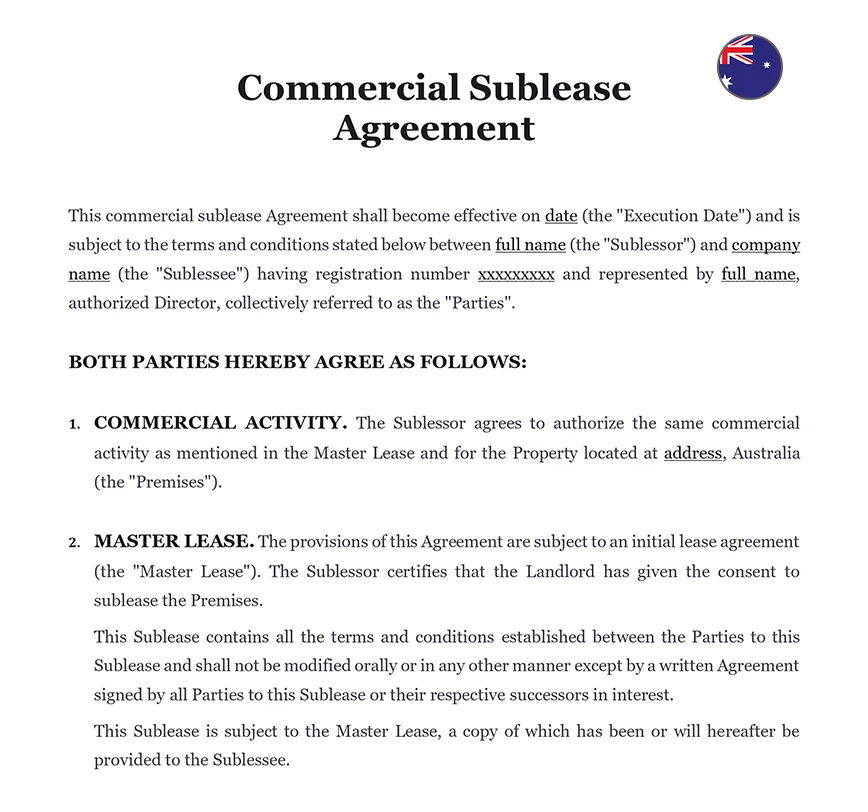Ready to use legal template
Drafted by experienced lawyers
Compliant with Australian law
Ready to use legal template
Drafted by lawyers
Compliant with Australian law
Home › Rent your property › Commercial sublease agreement
Learn more about Commercial Sublease Agreement in Australia
In Australia, a Commercial Sublease Agreement is a legal contract between the original tenant (the sublessor) and a third party (the sublessee) to lease all or part of a commercial property, such as office space, retail premises, or industrial warehouses. This agreement outlines the terms and conditions of the subleasing arrangement, including rent payments, responsibilities, and duration. It serves as a crucial document to formalize the relationship between the parties involved and ensure clarity on rights and obligations in a commercial setting. To facilitate this process and ensure compliance with Australian laws, we offer an easy-to-edit legal template meticulously crafted by legal experts, streamlining the creation of Commercial Sublease Agreements while upholding legal standards.
Table of contents
-
What is a Commercial Sublease Agreement?
-
What does a Commercial Sublease Agreement include?
-
What are my rights and responsibilities as the original tenant in Australia?
-
Do I need permission from my landlord to sublease the commercial property?
-
Are there any restrictions on alterations or modifications to the leased space?
-
How does insurance coverage work for subleasing in Australia?
-
Can I include utilities and other expenses in the sublease agreement?
-
What happens if the landlord terminates the original lease in Australia?
What is a Commercial Sublease Agreement?
A commercial sublease agreement in Australia is a legally binding contract between the primary tenant (sublessor) and a third party (sublessee) that permits the sublessee to lease part or all of a commercial property from the sublessor. This agreement outlines the terms and conditions of the sublease, including the duration of the sublease, rental payments, permitted use of the premises, and responsibilities of both parties. Commercial subleases are common when a primary tenant has excess space or wishes to vacate the premises temporarily. However, sublessors must obtain consent from the primary landlord and ensure compliance with the terms of the primary lease and relevant laws and regulations governing subleasing in Australia.
ℹ️ Themis Partner also provides a professionally drafted Sublease Agreement in order to comply with Australian Laws for a residential property.
What does a Commercial Sublease Agreement include?
Key terms commonly included in a commercial sublease agreement in Australia include:
1. Parties:
Identification of the sublessor (primary tenant) and sublessee (third party).
2. Premises:
Description of the leased commercial space, including address and any specific areas or amenities.
3. Term:
Duration of the sublease, including start and end dates.
4. Rent:
Amount of rent to be paid by the sublessee, frequency of payments, and any applicable rent increases.
5. Permitted use:
Restrictions or allowances regarding how the premises may be used by the sublessee.
6. Utilities and expenses:
Allocation of responsibility for utilities, maintenance costs, property taxes, and other expenses.
7. Assignment and subletting:
Provisions governing the sublessee’s ability to assign or sublet the premises to another party.
8. Default and remedies:
Consequences of default by either party, including late payments, breaches of the agreement, and procedures for resolving disputes.
9. Indemnification and liability:
Responsibilities for damages, injuries, or losses incurred on the premises.
10. Indemnification and liability:
Key terms commonly included in a commercial sublease agreement in Australia include:
These key terms serve to clarify the rights and obligations of both parties and ensure mutual understanding and compliance with the sublease agreement.
What are my rights and responsibilities as the original tenant in Australia?
As the original tenant in Australia, you have certain rights and responsibilities outlined in your lease agreement and governed by landlord-tenant laws.
1. Rights of the original tenant (or sublessor):
| ➤Sublease Rental Income:You have the right to collect rent from the subtenant as specified in the commercial sublease agreement. |
| ➤Use of Premises:You can specify how the subtenant may use the commercial premises, within the constraints of your original commercial lease. |
| ➤Property Condition:You have the right to expect the subtenant to maintain the commercial property in good condition and return it in the same condition as when the sublease began, barring normal wear and tear. |
| ➤Enforce Terms:You have the right to enforce the terms of the commercial sublease agreement, including rent payment and adherence to the use and maintenance conditions. |
| ➤Terminate Sublease:You have the right to terminate the commercial sublease if the subtenant breaches any terms of the sublease agreement, subject to any notice requirements and legal procedures. |




